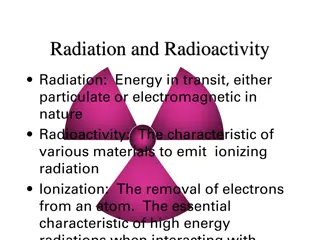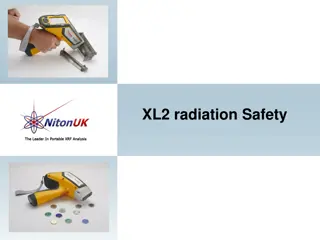X-ray Radiation Safety Training
Basic knowledge on X-ray radiation protection to comply with Regulation 15 of the Ionising Radiations Regulations 2017. It covers safety legislation, ICRP principles, UK legislation development, annual dose limits, and regulatory practices.
Download Presentation

Please find below an Image/Link to download the presentation.
The content on the website is provided AS IS for your information and personal use only. It may not be sold, licensed, or shared on other websites without obtaining consent from the author. Download presentation by click this link. If you encounter any issues during the download, it is possible that the publisher has removed the file from their server.
E N D
Presentation Transcript
X-ray Radiation Safety Training
Aim The aim of this presentation is to provide a basic knowledge in ray radiation protection to satisfy the requirements of Regulation 15 of the Ionising Radiations Regulations 2017. Every employer shall ensure that those of his employees who are engaged in work with ionising radiation are given appropriate training in the field of radiation protection
Radiation Safety Legislation
International Commission on Radiological Protection (ICRP) 1928 2nd International Congress of Radiology set up a commission: as an appropriate body to give guidance in the use of radiation sources as an international authority in the field of radiation
ICRP 60 (Published 1990) 3 principles Justification there should be a net benefit Optimisation restriction of exposure by As Low As is Reasonably Practicable (ALARP) principles Limitation set dose limits should not be exceeded 1. 2. 3.
Development of UK Legislation ICRP Principles European Atomic Energy Committee (EURATOM) Directives Health and Safety at Work etc Act 1974 Ionising Radiations Regulations 2017 Approved Code of Practice L121 Guidance Notes University Policy and Guidance Work with Ionising Radiation School / Service Local Radiation Safety Rules
Annual dose limits Whole body Extremities and skin Lens of the eye Employees aged 18 and over 50 mSv 500 mSv 20 mSv Trainees aged 18 and under 6 mSv 150 mSv 15 mSv Any other person 1 mSv 50 mSv 15 mSv Women of reproductive capacity - exposure of abdomen limited top 13 mSv in any consecutive 3 month period.
Ionising Radiations Regulations 2017 Notification of practices, including justification Radiation Risk Assessments Restriction of exposure Local Rules Appointment of RPA and RPS Designation of Classified Persons Designation of Controlled and Supervised Areas
Ionising Radiations Regulations 2017 continued Dose assessment and recording Information, instruction and training Pregnant and breast feeding female employees Arrangements for the control of radioactive substances, articles and equipment including loss or theft Duties of employees
Radioactive decay Alpha, Beta and Neutron - particles Gamma and X-ray electromagnetic radiation
X-Ray production Changes in electron orbit Slowing down electrons Slowing down beta particles (Bremsstrahlung) High Voltages
X-Ray production X-rays are capable of traversing great distances and can penetrate material However, they can be blocked or attenuated by shielding made from dense materials such as lead and concrete
Energy of Radiation Most of the radiation from an X-ray set is multienergetic Range of energies can be varied - - Increasing the voltage (kV), increases intensity of the X-ray beam, as does - Increasing the current (mA)
Primary Beam and Scatter Radiation Primary Beam The primary beam is a significant hazard, even very short exposure times can result in severe radiation burns Scatter radiation Produced when the primary beam interacts with samples and structures in the X-ray enclosure. Scatter radiation is a hazard near the sample Leakage radiation From the X-ray tube is very low and not a hazard when the tube housing is intact
Radiation Dose Quantities and Units Absorbed dose Energy deposited per unit mass by any type of ionising radiation (Gray) Equivalent Dose Dose allowing for type of radiation (Sievert) (absorbed dose x radiation weighting factor) Effective Dose Dose allowing for type of tissue (Sievert) (equivalent dose x tissue weighting factor)
Biological effects of radiation Health effects are determined by the type and intensity of the radiation and the period of exposure
Radiation Effects - Ionisation Direct ionisation Structural cell damage, weakens links between atoms Indirect ionisation Damage to chemical constituents, e.g. water Formation of free radicals
Radiation effects Stochastic effects (long-term): somatic and hereditary effects Effects will appear slowly because the body has time to heal itself after exposure. The effects, if any, will appear 20-30 years after exposure. Deterministic effects (immediate): loss of function also termed Tissue Reactions One-time event / High level doses involved (>100 rem or 1 Sv) / symptoms appear quickly (within days or weeks)
Harmful Tissue Reactions Effects 50 mSv - body repairs itself 1 Sv - nausea and vomiting 3 Sv - Erythema, blistering and ulceration 6 Sv - LD50depletion white blood cells, 50% population exposed die of infection death 10 Sv - severe depletion of cells lining intestine, death due to secondary infections
Radiation burns Occur as a result of an acute localized exposure Radiation burns can occur from a wide range of exposures and usually result from direct exposure to the primary beam. High-energy X-rays readily penetrate the outer layer of skin that contains most of the nerve endings, so you may not feel an X-ray burn until the damage has been done. Extreme cases involve skin grafts or amputation of fingers The hands, fingers and eyes are the parts of the body most commonly at risk The severity of the burn will depend on the dose received, the length of the exposure, the energy of the X-rays and the sensitivity of the individual
Instruments for detection of X-rays Count rate meters cpm / cps Dose rate meters Sv/hr, mSv/hr Dosemeters Sv, mSv
Types of Portable Monitors Ion chambers Scintillation detectors Geiger-Muller Detectors
Instrument selection Type of radiation Energy of radiation Range of radiation Response time
Suitable Monitors For Leakage Detection Thin scintillation crystal e.g., mini type 44 probe (>10keV for Al, >7keV for Be window) Uncompensated GM tube e.g., mini 900X For Dose Rate Estimation Ionisation chamber (>7keV) Energy compensated GM e.g., mini900D
Pre-use Monitor Checks Is it the correct type of equipment? Is it in good repair? Is the battery ok? Does it have a reasonably low background count? Is it in Calibration?
Personal Dosimetry Whole body / skin TLDs, PLDs Eye dose TLD chips Extremities Ring badges or TLD chips
External Radiation Controlling the hazard: Optimise shielding Maximise distance Minimise exposure Minimise intensity
X-Ray Machine Terminology The Primary / Useful Beam The Primary or Useful Beam is the beam emitted by the X-ray tube after it passes through an aperture in the source housing Shielding, such as a beam-stop, will prevent the primary beam from escaping the enclosure or damaging internal components of the XRD The exposure area of the primary beam can be less than 1 cm2 The hands, fingers and eyes are the parts of the body most commonly at risk from primary beam exposure
X-ray Equipment Closed beam An analytical X-ray system in which all possible X-ray paths (primary, scatter and diffracted) are completely enclosed so that no part of the human body can be exposed to the beam during normal operation The X-ray tube is installed in an enclosure which is intended to provide radiation shielding, and prevent access to its interior during generation of X-ray radiation These units are the safest of the analytical X-ray units because they prevent exposure to the primary beam by including numerous safety interlocks The enclosure also have built-in shielding within the unit to prevent exposure to scatter radiation
X-ray Equipment Open beam An analytical X-ray system that is not enclosed An individual could accidentally place a part of the body in the primary beam path during normal operation Open units present the greatest potential for injury because the primary beam is accessible to the user
Portable X-ray Fluorescence Analysers (XRF) Operated in an open-beam configuration, but the sample must be in contact with the XRF before the XRF will irradiate the sample The XRF must have a built-in proximity sensor and backscatter detector Both these safety devices are used to prevent accidently firing the x-ray without a sample placed against the beam port
Portable X-ray Fluorescence Analysers (XRF) The Society for Radiological Protection (SRP) have produced guidance on the safe use of handheld XRF analysers (Pub. 2012) This document is available on request from the University Radiation Protection Advisor
Safety Features Machine Controls Beam Shutter: Opens or closes, allowing or preventing the primary beam to pass Beam Stop: composed of dense material (e.g. lead) that will absorb the primary beam that passes through and around the sample. This device works to stop the primary beam and reduce the scatter radiation that would be caused if the primary beam were to strike components of the unit housing Fail-Safe Characteristics: a design feature which closes the beam port shutters or turns off the x-ray generator to prevent exposure to the primary beam upon failure of the safety warning device. All safety and warning device must be failsafe X-Ray On light must be present and failsafe Locks to the enclosure doors must be failsafe
Safety Features Machine Controls continued Beam Collimation: Focus the primary beam on the area of interest. Collimation prevents exposure to unwanted areas, reducing scatter radiation Unit Enclosure: Equipment housing designed to prevent exposure from the primary beam. These enclosures may be fitted with leaded glass windows and safety interlocks which all work to prevent the operator from being exposed to the primary beam and secondary scatter radiation
Safety Features Machine Controls continued Interlocks: A series of switches and circuits that must all be connected in order for the primary beam to operate. The switches are generally connected to the warning lights, doors, beam shutter and collimator. If any of these switches are triggered and opened, the beam will shut down Standard Operating Procedures: Step-by-step instructions necessary to accomplish the analysis. These procedures shall include sample insertion, manipulation, equipment alignment, routine maintenance by registrant, and data-recording procedures which are related to radiation safety
X-ray Unit Safety Features The safety features of X-ray units will vary depending on the type of unit being employed (i.e. cabinet, closed beam, open-beam, XRF) Open-beam units have the highest potential for dangerous exposures to occur because they allow the user to have access to the primary beam Closed-beam and cabinet units are much safer to work with because they have safety features preventing the user from accessing the primary beam
X-ray Unit Safety Features continued All enclosed X-ray units include the necessary safety features needed to prevent access to the primary beam and keep the potential exposures to the user at safe levels Portable XRF s require adherence to special safety practices and procedures to avoid exposure to the primary beam Familiarise yourself with your unit s safety features prior to use
Safety Practices Never bypass a safety device such as interlocks and failsafe features, shutters, etc. without approval from the School / Service Radiation Protection Supervisor, as such devices are meant to protect you from serious harm and injury Understand the risk assessment and controls measures relating to the x-ray unit you operate Learn the Standard Operating Procedures for each X-ray unit you operate
Safety Practices continued Do not operate a unit in any manner other then specified in the Standard Operating Procedures Do not allow anyone other than trained and certified personnel to operate the unit Always follow the ALARP principles: Time, Distance, Shielding, Dosimetry
Safety Practices continued Do not remove covers, shielding material or tube housing or perform modifications to shutters, collimators or beam stops without verifying the x-ray tube is off and will remain off until safe conditions have been restored. The main on / off switch, rather than interlocks, must be used for routine shutdown Never place any part of your body in the primary beam Never use hands to hold a sample e.g. sample analysis with a handheld XRF
Safety Practices continued Do not attempt to operate if the X-ray unit is not mechanically intact and sound Always control access to radiation producing equipment during use to avoid unintentional exposures Always know the location and presence of the primary and diffracted / scattered X-ray beams
X-ray Safety Film It is recommended all users of X-ray generating equipment view the following safety film right click on the title below and select open link to watch the film via YouTube The Double Edged Sword Video
University of Bristol Arrangements All users of sources of ionising radiation must register on the central University Radioactive Sources database and ensure their registration is reviewed every year Risk assessments for use of x-ray generating equipment may be recorded on the central Radioactive Source Database, electronically, or paper copy, depending on the School / Service All users must sign-off risk assessments to state that they have read and understood all control measures required for safe operation
Accidents / Incidents Report from an x-ray radiation incident in France: Accidental exposure of researchers hands to an X-ray crystallography beam Incident During a crystallography analysis, two people handled the sample when the X-ray diffraction device was on The collimator and beam stop, which was normally used to provide protection, had been removed
Accidents / Incidents continued The two people did not realise that the device was on The exposure time was estimated at 40 seconds and the distance between the X-ray source and the persons was approximately 40 cm It is estimated that the hands crossed the X-ray beam on several occasions























